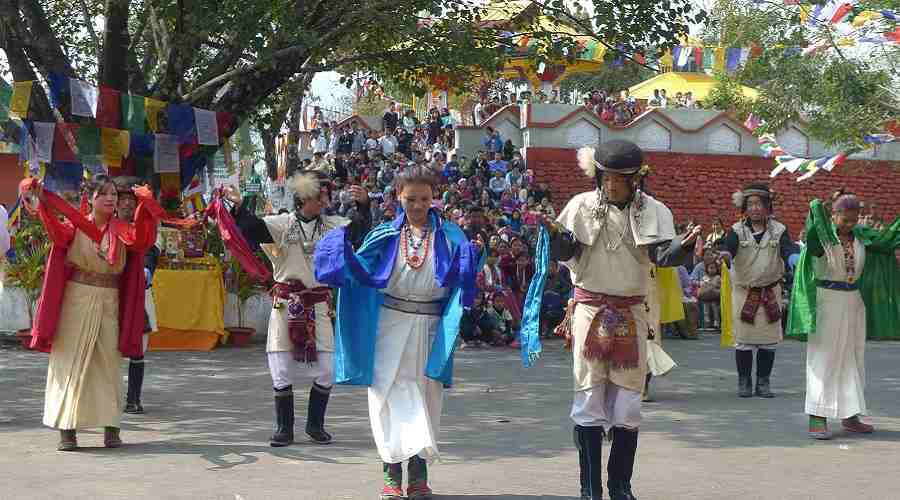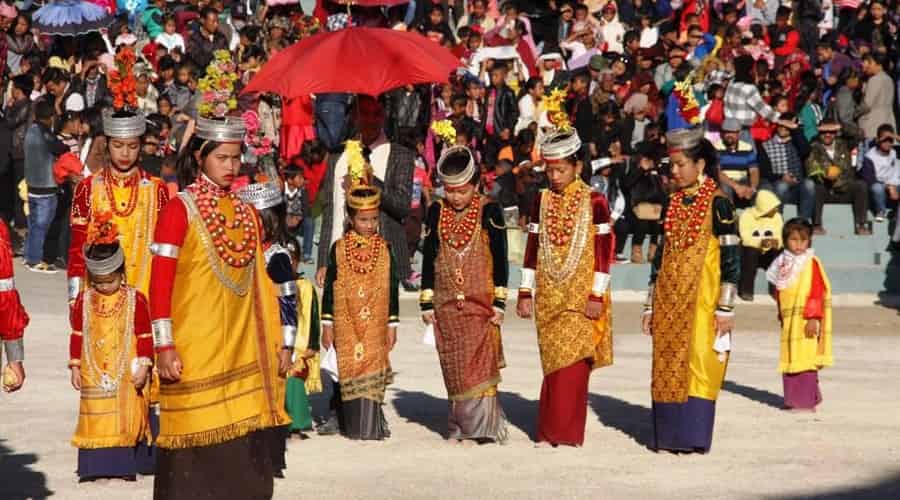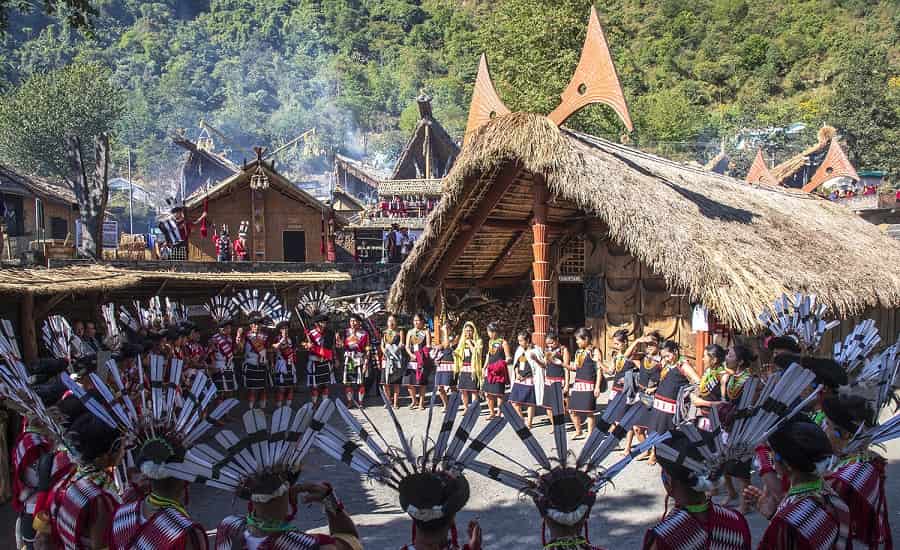Northeast India known for its natural beauty and rich biodiversity. The mystic land of north-east is inhabited by a large number of different ethnic groups, having their own customs and traditions. The land of diverse culture is well reflected by the different festivals celebrated by different ethnic groups all throughout the year. The festivals are celebrated either to mark the change of season, beginning of a new year or the rich culture. Each festival exhibits the rich culture and is celebrated with grandeur as well as zest. The important festivals celebrated in each of the North-Eastern state are enumerated below:
Bihu, Assam

Bihu is the cultural festival of the North-Eastern state of Assam, which is celebrated throughout the state with grandeur. The festival is celebrated thrice a year to mark the change in season as per the Assamese calendar. A festival that transcends all religion, caste, creed and class barriers, Bihu brings together all the Assamese people together to celebrate it with great enthusiasm and fervor. It is the state festival of Assam and like all other festivals, even this festival has a history related to it. It was celebrated during 3500 B.C. for the first time and even today it is celebrated with great zest and grandeur. The three Bihus that are celebrated in the state namely, Bohag Bihu or Rongali Bihu; Kati Bihu or Kongali Bihu and Magh Bihu or Bhogali Bihu. Each of these has special significance and reflects the rich culture of the state.
- Rongali Bihu is celebrated to mark the beginning of Assamese New Year as well as to welcome the spring season. It is celebrated during the month of April, which continues for seven days. It is celebrated all over the state with grandeur and the whole environment lightens up with the sound of Bihu songs and dances.
- Kati Bihu is celebrated in mid of October, when the crops are just planted and the granaries of the farmers are approximately empty. It is not associated with merriment, rather as sense of solemnity and restrain can be felt in the environment. On this day, Tulsi plant is planted on the fields seeking blessings for prosperity and protection of the paddy from being affected.
- Magh Bihu or Bhogali Bihu, which is a harvesting festival. It is celebrated in the month of Magh of the Hindu calendar and mid-January of the Georgian calendar. It is a feasting festival as the granaries of the people are full and people get together to celebrate this festival.
Losar Festival, Arunachal Pradesh

Although different festivals are celebrated in Arunachal Pradesh by different tribes that reside in the state, but Losar is one of the major festivals, which is celebrated in the Tawang district. It is a religious festival of the Buddhists that is celebrated with grandeur and marks the Monpa New Year. The word Losar is a Tibetan word and the festival marks the fending off evil spirits and welcoming the New Year, which is filled with happiness and opulence. It is one of the most important festivals of the state and generally falls in the months of January, February or March as per the Gregorian calendar. During this festival people clean up and decorate their homes, preparing to welcome the New Year. The festival is celebrated from the first to the third of the first lunar month.
Sajibu Cheiraoba, Manipur

Celebrated in the state of Manipur, Sajibu Cheiraoba is one of the most important festivals of the state. It marks the beginning of the New Year of the Meitei people of the state. This festival celebrated in every household, which is celebrated in the month of Sajibu of the Meitei calendar and April according to the Georgian calendar. It reflects the cultural, social as well as the religious aspirations of the people of the state. Sajibu Cheiraoba is also associated with Chahitaba, the man who gives his name to the year bearing all the sins of the people for the year, bringing good luck for the entire community.
On this festival the local deity Sanamahi is worshipped in every household. Cleaning the houses, decorating it and exchanging gifts are the common rituals followed during this festival. On this day the local people climb the nearest hill tops as it signifies the growth and prosperity of human civilization in every sphere of life. It is celebrated with grandeur and great enthusiasm.
Chapchar Kut, Mizoram

Chapchar Kut is an important festival celebrated in the state of Mizoram. It is a spring festival as well a harvest festival celebrated in the month of March. The festival is celebrated with gaiety and great pomp and show. It is a weeklong festival and the sound of the beatings of the gongs echoes in the surrounding hills. White flag flying in the air and the sweet smell of flowers lingers in the air. During this festival every person, young and old, dresses themselves in colorful costumes, headgears and jewelries. Everyone gather together and perform folk dances, sing songs, accompanied by gongs and beating of drums. The entire environment of the state is filled with joy and this festival is celebrated with grandeur.
Nongkrem Dance Festival, Meghalaya

Bestowed with natural beauty, the state of Meghalaya celebrates the Nongkrem Dance Festival in the Khasi Hills during the autumn season. This is a religious festival as well as harvest thanksgiving by the Khasi tribe, which is celebrated for five days. During this festival goat sacrifice is an important ritual, which is followed by beating of drums and blowing of pipes to mark the grandness of the festival. One of the highlights of this festival is that young virgin girls perform dance on the specially prepared festival fields. They deck up in traditional costumes and heavy gold traditional jewelry. Young men and women perform traditional dance, where the man holds a sword symbolizing protection of their families. People offer prayers to Ka Pah Syntiew and U Suid Nia Tong Syiem on this auspicious occasion.
Hornbill Festival, Nagaland

Hornbill festival is one of the most important and major festivals celebrated in the state of Nagaland. It is an annual festival, which is celebrated every year in the month of March displaying the rich cultural heritage of the state. This festival is organized by the State Directorate of Tourism, Government of Nagaland to bend inter-tribal associations and to strengthen cultural heritage of the state. It is an endeavor to demonstrate the unification of the culture of different tribe residing in th state under one circlet. It is held at Naga Heritage Village in Kisama, which is about 12 km from Kohima, the state capital. People from every tribe take part in this festival, displaying an invigorating and affluent ethnicity. It is a weeklong festival, which is celebrated with grandeur and during this time the entire state lightens up with joy and gaiety all over.
- See Also: Fairs & Festivals Celebrated in Nagaland
Kharchi Puja, Tripura

Kharchi Puja is the most important festival celebrated in the north-eastern state of Tripura. It is a religious festival celebrated for a week during the month of July. During this festival mother earth is worshipped, which is performed at the premises of the Chaturdasha Devta temple in Agartala. It is performed after 15 days of Ama pechi or Ambu bachi, which is the period when Mother Goddess as well as Mother Earth goes through the menstrual cycle. During this festival 14 deities are worshipped, which is performed by members of Chantai, a tribe of Tripura. Goats, fouls and buffalos are sacrificed during this festival and offered to the deities along with sweets. Also, a large fair is organized on this occasion and a huge crowd of people visit the temple as well as the fair on this occasion.
- Also Read: Famous Hindu Temples in North East India
Saga Dawa, Sikkim

One of the major festivals celebrated in the state of Sikkim is Saga Dawa. The festival is celebrated to commemorate the life of Buddha. It is a Buddhist religious festival, which is celebrated according to the Tibetan lunar month. Saga Dawa is one of the most auspicious festivals celebrated by the Buddhists and is considered three-fold-auspicious festival, which marks the birth, enlightenment and salvation of Buddha. It falls on the full moon day of Buddhist lunar calendar and as per the Georgian calendar it falls either in the month of May or June. The festivity starts with a procession of the holy books that contains the teachings of Lord Buddha, which starts from Tsuk-La-Khang Monastery through the streets of Gangtok. During this festival the monasteries are decorated and lightened up with lamps. The entire state celebrates this festival with grandeur.
The entire North-East region celebrates numerous festivals throughout the year. However, these are some of the most important and major festivals celebrated in each of the states. Each of these festivals are celebrated with grandeur and zest, which makes them worth watching.